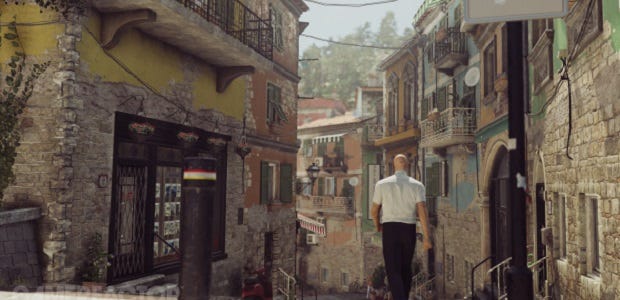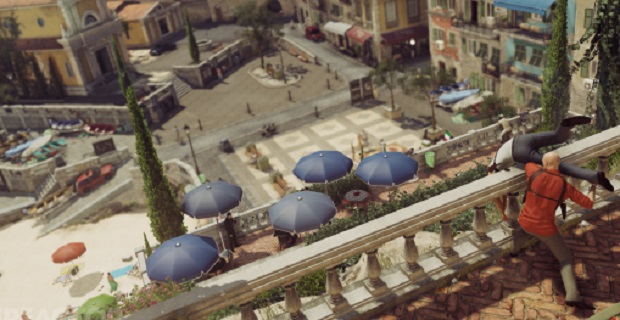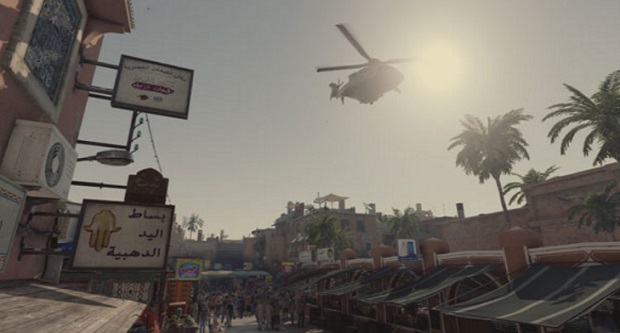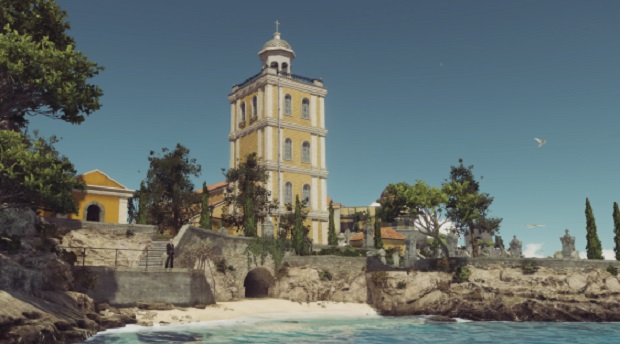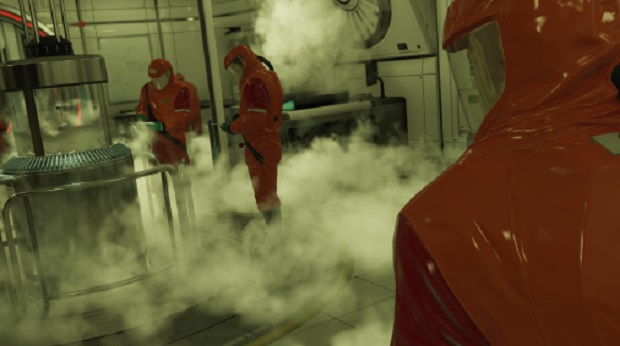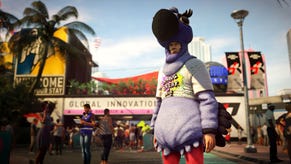Hands On: Hitman Hits Its Stride In Sapienza And Marrakesh
See the sights
After the flashbulbs and pulsing techno of Paris, Hitman [official site] Episode 2's Sapienza level feels like a holiday – the kind of holiday John Le Carre writes about, in which lingering over your espresso is tantamount to painting a bullseye on your back. Set on the Italian coast, the chapter opens with Agent 47 idling on a bench opposite a fortified mansion belonging to your target, a bioweapons scientist whose latest creation must be nipped in the bud. Under an archway to your left, two sheepish flower delivery drivers are tending to an unconscious cyclist. Somewhere behind you, a couple of heavyset gentlemen chat quietly about a secret laboratory. Off to the right, a woman in the street bellows up at her partner, a sous-chef who is late for work in the mansion's kitchen.
It's a world of threads begging to be yanked on, the better to hoist somebody by the neck, but what's your hurry? You've got your paper and the sun is out. With its postcard locales and indulgent pacing, Hitman has always been something of a tourism simulator, and in Sapienza, IO has conjured up the perfect ambience – bottomless blue skies, dusky cobblestones and guidebook hotspots roamed by sweaty foreigners in ridiculous shorts.
Thus far Sapienza and Episode 3's Marrakesh are a confident advance on the new game's promising first map. They're more varied and organic than Paris, slopped across districts and population centres rather than confining themselves to a single base or building. There's the same excess of dialogue to sit through while tailing mission-critical NPCs, the same slightly obnoxious proximity-based event scripting, but you're more at liberty to rove about and tinker. It's a question of premise. The Showstopper was a tightly managed theatre production broken up into easily comprehended zones and levels, a clear-cut introduction to Hitman's core principles, whereas Sapienza and Marrakesh are simply places. They feel a bit less artificial, less dependent on player participation.
Things to do while ambling through Sapienza include breaking into a lawyer's office to sabotage the CCTV, eavesdropping on a barbershop conversation about a private investigator, going to (and possibly receiving) confession, and attempting to throttle a street performer in broad daylight. You can also punch a priest inside out, though I'm not sure that particular gambit will survive QA. In keeping with Hitman tradition, outfits you can borrow run the gamut from the boringly effective, such as guard uniforms or lab coats, to the comic and/or suicidal. I've yet to find a use for the stoner get-up in the attic, for instance, but I'm sure an idea will present itself. Give me time.
As before, the Opportunities waypoint system is there to walk you through certain methods of nobbling the quarry, though why you'd buy into a sandbox as highly wrought as this only to reduce it to a breadcrumb trail is another question. Opportunities remain as obtrusive as desired – you can limit the system to giving you objectives without any further guidance, or turn it off completely. It's one of the more intelligently scaled tutorial elements out there, but I think the problem with Opportunities, most of which are dialogue-heavy, isn't what they do but what they're symptomatic of - scenario design that too often tells a tale at the expense of what the world can offer. There's a hunger to provide context or strike a tone that occasionally stops me taking pleasure in the stories you can weave around items and NPC behaviours.
It's never a deal-breaker, but I think IO is still learning to walk the line between its ambitions for Hitman as a drama and its ambitions for the sandbox. An example of not quite nailing this balance from Sapienza would be the gambit that involves placing or triggering domestic objects in sequence to prompt a hysterical fit, causing your victim to seclude himself from his guards. It's a nice conceit, but I felt like I was following a script rather than putting my own cunning to work (not least because there are precedents in older games). Those who prefer to keep their distance might want to check out the ruined fort that overlooks the mansion's infinity pool. I'm told there's a cannon or two left on the battlements.
Where Sapienza takes the pressure off, Marrakesh returns you to the heart of the storm. Going by a hands-off fly-through demo, it could be Hitman's largest and busiest map to date. Your targets this time are a banker convicted of fraud who has taken refuge in an embassy, and a general who is on the verge of launching a coup d'etat. There is, it must be said, a sense that Io is leafing through the annals of espionage cinema at this point: if Paris was a Bond movie and Sapienza is The American, Marrakesh puts me in mind of Stephen Gaghan's Syriana.
The most striking things about this map are its politically charged blend of styles and scales, and its probably illusory atmosphere of imminent crisis. The city itself is another nod to the daytripper in every player, thick with details plucked from the pages of the National Geographic - winding alleys hung with arabesques, stalls packed with gaudy faux-brand electronics and even the odd snake charmer. The initial spawn drops you by a crowd staring at live TV footage of the protest rally outside the embassy's main entrance, a clever scene-setting device that makes the map feel even larger by placing one corner at a journalistic remove.
Inside the subdued and spacious embassy building, there's an air of panic as staff peer through the turnstiles at screaming citizens waving megaphones and placards. The rogue general, meanwhile, lurks with his troops in an abandoned secondary school that lends itself to a classic base infiltration, with regularly spaced windows and long corridors. Other points of interest include a mysteriously well-protected shoe shop, rooftop gardens and an underground carpark.
The aspect of Marrakesh that intrigues me most is the protest rally, which looks like a riot waiting to be elbowed into action. If that's allowed for in the mission design, it could be either a brilliantly callous way of invading the embassy - swept through the checkpoint by a tide of agitators - or a sad reminder that many of the new Hitman's bystanders are just furniture, however responsive they may seem at a glance. Let us not forget the spectacle of the Parisian jet set pondering the dregs of their cocktail glasses while the party's host bleeds out on the catwalk.
Assuming IO's designers and programmers can do the idea of an NPC insurrection justice, however, Marrakesh could be a gripping departure. Most Hitman levels are clockwork dioramas waiting to be interfered with, whereas this map feels like it might transform under its own steam. Imagine having to backtrack across a city reduced to one giant pub brawl after collecting your bounties, or closing in on the general after he's dispatched his guards to quell the rioters.
Marrakesh is also a chance to take a more searching look at street-level political dissent than is permitted by, for example, Tom Clancy's The Division, which launched in the same week as Hitman Episode 1. Unwieldy though it is, the comparison fascinates me because both games are basically about dress code. The Division poses an authoritarian fantasy in which society's discontents are marked for extermination by their hoodies, masks and baseball caps, to say nothing of an in-world HUD that has no patience for moral niceties.
In Hitman that readiness to judge by appearances is liberating – if you are what you wear, the social hierarchy is what you make of it. Marrakesh could be an especially provocative exploration of this, as it dumps you right into the breach between the haves and have-nots. If there's anything about the unfolding Hitman saga I'd be genuinely happy to hear aired in mission dialogue or even, whisper it, a cutscene, it's how the premise allows you to float above class distinctions where most games tacitly ask you to take sides.
Failing that, maps that boil off some of the rigidity and staginess we saw in Paris are reason enough to keep plugging away. Sapienza is perhaps a shade too familiar – I'm not allowed to talk about the secret laboratory in detail, but suffice to say that it changes the tempo and theme in ways a fan of the series would expect. Marrakesh, however, looks like IO pushing out of its own comfort zone. It should be, at the very least, an exciting and complicated failure.
Hitman's Sapienza episode is out April 26th.
